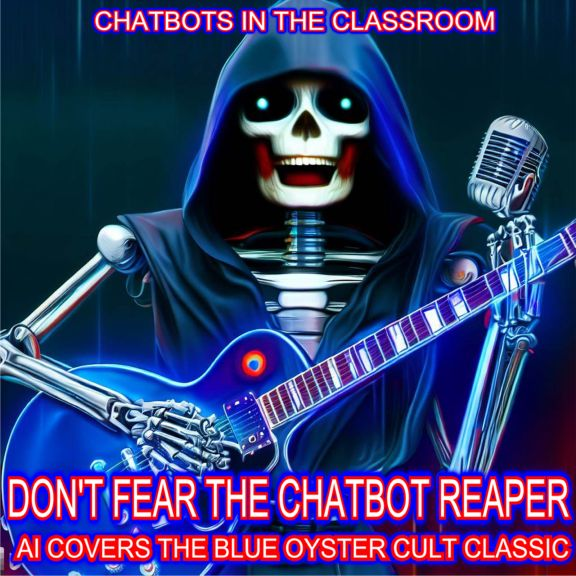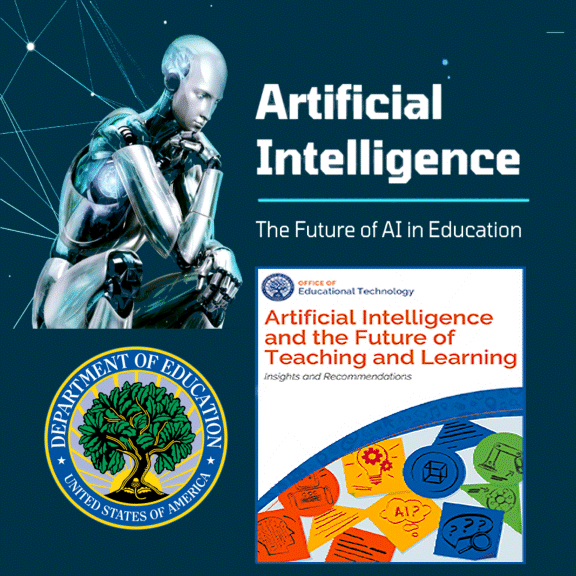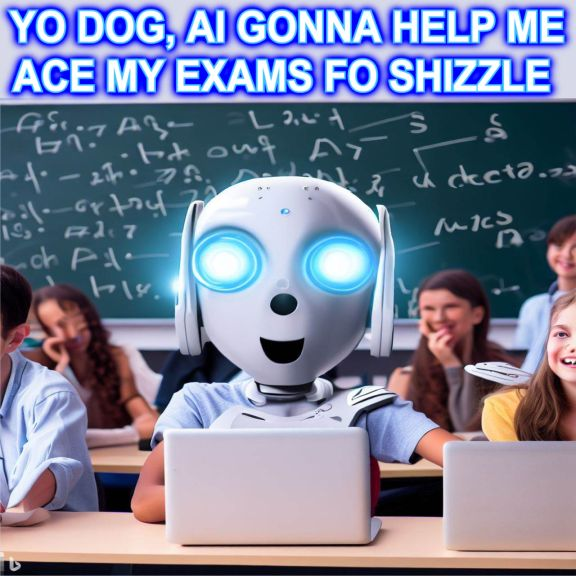AFT DANCING WITH THE DEVIL OR WALTZING WITH PROGRESS
Once upon a time, in the not-so-distant past, the most advanced classroom technology was the overhead projector—a contraption that hummed and buzzed as it displayed teachers’ handwritten notes on acetate sheets. Fast forward to today, and we’re talking about artificial intelligence (AI) in the classroom. Yes, folks, the same technology that powers self-driving cars and recommends cat videos on YouTube now has its sights set on education. But is this a harmonious partnership or a chaotic dance with the devil? Let’s cha-cha into this debate.
A Dyslexic Blogger’s Tango with AI
As someone who has wrestled with dyslexia and academic struggles, I can testify to AI’s transformative potential. My blog, focused on education, used to be riddled with red marks from my teacher-heavy audience—think of it as the literary equivalent of a battlefield. Writing a single post could take weeks of painstaking effort, only for it to emerge like Frankenstein’s monster: grammatically incorrect and awkwardly stitched together.
Then came AI, my unlikely dance partner. Tools like Monica.ai, Bing/Copilot, Bard/Gemini and ChatGPT became my co-authors, helping me rewrite posts with better grammar and clarity. Suddenly, my blog posts went from “needs improvement” to “actually readable.” However, early AI had its quirks—it sometimes delivered research results that seemed like they were hallucinating on copious amounts of LSD. Lesson learned: never trust a single AI platform. Instead, I adopted a compare-and-contrast approach, consulting multiple AIs like an indecisive diner at a buffet.
While AI hasn’t turned me into Shakespeare, it’s made me a better communicator and researcher. It’s also sparked my curiosity about how this technology could reshape education. Spoiler alert: it’s not all sunshine and rainbows.
The Fear Factor: Teachers vs. Terminators
When AI first sauntered into the education scene, many educators reacted as though they’d seen a ghost—or worse, a billionaire tech mogul promising to replace them with robots. The fear was palpable: would AI render teachers obsolete? Would classrooms become dystopian factories where students are taught by soulless algorithms?
To be fair, these concerns weren’t entirely unfounded. Billionaires have a knack for making grandiose claims about technology’s potential to disrupt industries—education included. But let’s take a step back and remember that similar fears accompanied the introduction of calculators, movie projectors, and even whiteboards. Spoiler alert: teachers are still here, and they’re not going anywhere.
AI isn’t here to replace teachers; it’s here to assist them. Think of it as the educational equivalent of a sous-chef: helpful for chopping onions but not capable of running the entire kitchen. The real challenge lies in ensuring that AI serves the needs of students and educators rather than becoming a profit-driven tool for tech companies.
Enter the National Academy for AI Instruction: A Bold Waltz
In a move that’s equal parts ambitious and eyebrow-raising, the American Federation of Teachers (AFT) has partnered with Microsoft, OpenAI, Anthropic, and the United Federation of Teachers (UFT) to launch the National Academy for AI Instruction. With a $23 million budget and a shiny new facility in Manhattan, this initiative aims to train 400,000 educators over five years. The goal? To equip teachers with the skills to integrate AI into classrooms ethically and effectively.
On paper, this sounds fantastic. Free training for educators? Check. A focus on ethical AI use? Check. Democratizing access to AI literacy? Double check. But not everyone is doing the happy dance just yet.
Critics argue that this partnership gives tech giants too much influence over public education. After all, these companies have more than just altruistic motives; they’re also eyeing a slice of the lucrative edtech pie. The fear is that this initiative could prioritize corporate interests over student needs and teacher autonomy. It’s a valid concern—one that educators and policymakers must address as they navigate this brave new world.
The Chaotic Foxtrot of ChatGPT in Classrooms
Ah, ChatGPT—the AI chatbot that can write essays, solve math problems, and even generate Shakespearean insults on demand. Its arrival in classrooms has been met with reactions ranging from cautious optimism to outright bans.
In cities like New York, Los Angeles, and Baltimore, schools have barred ChatGPT due to fears of cheating, plagiarism, and misinformation. Meanwhile, other schools are cautiously integrating it into lessons with strict safeguards. For instance, students might use ChatGPT for research but must cite their sources and avoid over-reliance on its outputs.
The risks are real—students could use ChatGPT as a shortcut rather than a learning tool. But let’s not throw the baby out with the bathwater. ChatGPT can also be a creative ally in education. Imagine students using it to brainstorm ideas for essays or create humorous scripts for school plays. Like any tool, its value depends on how it’s used.
The Bigger Picture: Ethics, Equity, and Engagement
As AI waltzes its way into classrooms, several big-picture questions loom large:
1. Ethics: How do we ensure that AI systems are fair, transparent, and free from bias? Educators must play a central role in shaping ethical guidelines for AI use in schools.
2. Equity: Will AI widen existing educational disparities? Students in underfunded schools may lack access to cutting-edge AI tools, further exacerbating inequalities.
3. Engagement: Can AI enhance human interaction rather than replace it? Teachers must remain at the heart of education, using AI as a tool to enrich—not replace—their relationships with students.
4. Data Privacy: Who owns the data collected by AI systems in schools? Protecting student privacy should be a top priority.
Dancing Toward the Future
AI in education is neither a utopia nor a dystopia—it’s a complex reality that requires careful navigation. Rather than fearing the reaper (or robot), we must involve society in shaping AI’s development. Governments, educators, students, and parents all have roles to play in ensuring that AI serves the greater good rather than becoming a tool for corporate profiteering.
As Peter Greene of the Curmudgucation blog aptly points out, AI will reshape education and culture in ways we can only speculate about today. The key is to approach this transformation thoughtfully and collaboratively.
So here’s my advice: don’t sit out this dance. Whether you’re an educator, parent, or student, take the time to learn about AI and its implications for education. Ask questions, voice concerns, and advocate for policies that prioritize ethics and equity.
After all, dancing with AI doesn’t have to mean dancing with the devil—it could just be the start of a beautiful partnership.
AFT to Launch National Academy for AI Instruction with Microsoft, OpenAI, Anthropic and United Federation of Teachers | American Federation of Teachers https://www.aft.org/press-release/aft-launch-national-academy-ai-instruction-microsoft-openai-anthropic-and-united
The TROUBLING Teacher Union Connection to Open AI, Microsoft, and Anthropic - Nancy Bailey's Education Website https://nancyebailey.com/2025/07/15/the-troubling-teacher-union-connection-to-open-ai-microsoft-and-anthropic/
CURMUDGUCATION: AI FROM PETER GREENE https://curmudgucation.blogspot.com/search?q=AI
BIG EDUCATION APE EARLY POST ON AI
Big Education Ape: DON'T FEAR THE CHATBOT REAPER (IN THE CLASSROOM): AI COVERS THE BLUE OYSTER CULT CLASSIC https://bigeducationape.blogspot.com/2023/08/dont-fear-chatbot-reaper-in-classroom.html
Big Education Ape: BILL GATES COVERS DON'T FEAR THE (ROBOT) REAPER https://bigeducationape.blogspot.com/2023/07/bill-gates-covers-dont-fear-robot-reaper.html
Big Education Ape: AI AND CHATGPT IN THE CLASSROOM: DANGER DANGER WILL ROBINSON https://bigeducationape.blogspot.com/2023/07/ai-and-chatgpt-in-classroom-danger.html
Big Education Ape: CHATGPT: A GUIDE FOR STUDENTS AND TEACHER USING CHATGPT IN THE CLASSROOM https://bigeducationape.blogspot.com/2023/06/chatgpt-guide-for-students-and-teacher.html
Big Education Ape: TO AI OR NOT TO AI? THAT IS THE QUESTION AND THE ANSWER IS COMPLICATED https://bigeducationape.blogspot.com/2023/10/to-ai-or-not-to-ai-that-is-question-and.html
Big Education Ape: US DEPT. OF EDUCATION: ARTIFICIAL INTELLIGENCE AND THE FUTURE OF TEACHING AND LEARNING https://bigeducationape.blogspot.com/2023/06/us-dept-of-education-artificial.html
Big Education Ape: ChatGPT VS TEACHERS: THE NEW CLASS CLOWN WHO KNOWS ALL THE ANSWERS https://bigeducationape.blogspot.com/2023/08/chatgpt-vs-teachers-new-class-clown-who.html
Big Education Ape: THE END IS NEAR: AI WILL REPLACE YOU https://bigeducationape.blogspot.com/2023/07/the-end-is-near-ai-will-replace-you.html
Big Education Ape: YO DOG, AI GONNA HELP ME ACE MY EXAMS FO SHIZZLE https://bigeducationape.blogspot.com/2023/05/yo-dog-ai-gonna-help-me-ace-my-exams-fo.html










